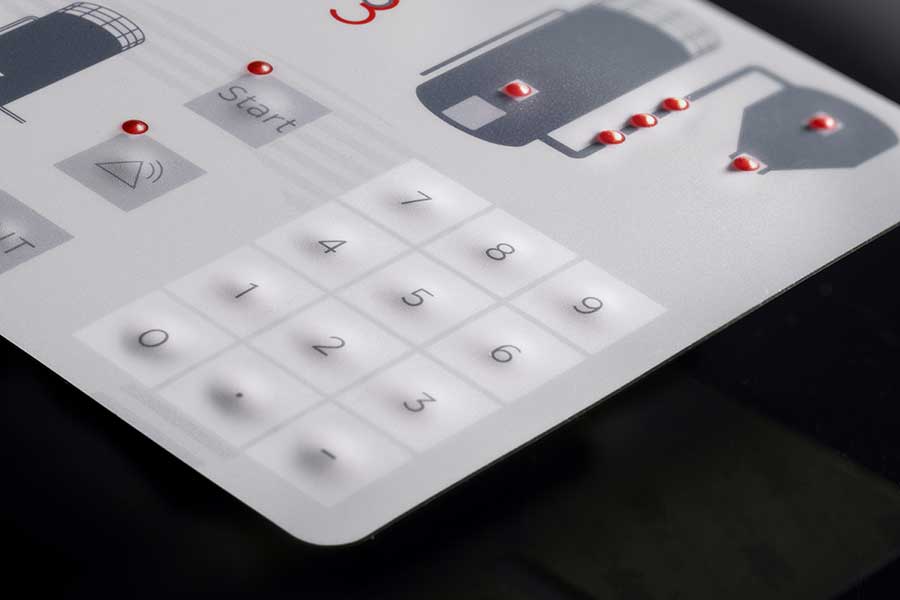Exactly How Membrane Switches Over Contribute to the Durability of Electronic Control Panels
Membrane buttons play an important function in enhancing the durability of digital control panels, largely with their multi-layered building which offers effective defense against environmental variables such as dampness and dust. The lack of moving parts substantially lowers the possibility of mechanical failures, making membrane switches over suitable for demanding applications.
Interpretation of Membrane Layer Buttons

Membrane layer buttons are made to be slim and light-weight, making them suitable for applications where space is restricted. They can be manufactured in various shapes, dimensions, and colors, offering adaptability in layout that fulfills visual and functional requirements. Furthermore, membrane switches can integrate different technologies, such as tactile feedback and LED indicators, improving individual experience.
Because of their construction, membrane layer buttons are often resistant to dust, moisture, and general wear, adding to their toughness popular settings. Their seamless style not only promotes very easy cleansing yet also decreases the threat of mechanical failing, making them a preferred selection for producers looking for trusted customer interfaces in their digital control board.
Defense Versus Environmental Variables
The style of membrane switches inherently gives a level of protection versus different environmental variables, which is important for preserving capability in challenging conditions - Membrane Switch. These buttons are commonly created with layers of versatile materials that secure interior components from dampness, dirt, and pollutants. By encapsulating the wiring, membrane switches lessen the danger of brief circuits and rust, which can substantially impair efficiency
Additionally, making use of durable adhesives and sealants throughout manufacturing improves their resistance to ecological challenges. Membrane layer buttons can sustain direct exposure to chemicals and solvents, making them suitable for markets such as food handling and healthcare, where hygiene and tidiness are vital. Their seamless surface style additionally prevents the accumulation of dirt and microorganisms, assisting in easier cleansing and upkeep.
Temperature level variations are another ecological concern, and membrane layer switches are engineered to operate successfully throughout a variety of temperatures (Membrane Switch). This flexibility ensures that control panels continue to be operational in different setups, from commercial environments to customer electronic devices
Influence On Individual Communication
Customer interaction with digital control board is dramatically affected by the design and performance of membrane layer buttons. These buttons offer a responsive user interface that boosts the overall customer experience, enabling instinctive navigating and control. Their responsive nature guarantees that customers obtain immediate feedback upon activation, which is vital for jobs calling for precision and efficiency.
Furthermore, the smooth surface of membrane layer switches helps with very easy cleansing and upkeep, advertising customer confidence in the reliability of the interface. This tidiness is specifically important in settings where hygiene is extremely important, such as medical or food processing setups. Furthermore, the small and lightweight design of membrane changes adds to the visual appeal of control panels, urging individual involvement with a modern and smooth look.
Furthermore, the integration of aesthetic aspects, such as published icons and backlighting, aids users rapidly identify features, minimizing the finding out contour associated with new equipment. Because of this, users can operate tools better, resulting in enhanced performance and fulfillment. In recap, membrane switches play a pivotal role in enhancing individual interaction by incorporating capability, visual appeals, and convenience of usage, eventually causing boosted operational performance.
Design Adaptability and Personalization
Style versatility and personalization are necessary aspects of membrane layer switches, allowing suppliers to tailor digital control board to specific applications and customer requirements. This flexibility enables for the integration of various design components, such as shades, graphics, and structures, which can improve the aesthetic allure and individual involvement of the control board.
Membrane switches can be customized in size and form, fitting a variety of devices and applications, from commercial published here equipment to consumer electronic devices. This convenience makes sure that makers can develop intuitive user interfaces that straighten with customer expectations and operational requirements. Furthermore, the ability to include distinct features such as backlighting or responsive feedback additionally enhances use, enabling an extra interactive experience.
Additionally, the production procedure for membrane layer changes sustains the quick prototyping of browse around here layouts, enabling producers to iterate and refine their principles swiftly. This capability not only accelerates the development timeline yet likewise guarantees that the last item fulfills specific practical and aesthetic requirements.

Cost-Effectiveness and Long Life
Cost-effectiveness and durability are significant advantages of membrane layer buttons, making them an appealing choice for suppliers and end-users alike. These switches are generally cheaper to create than traditional mechanical switches, primarily because of their streamlined manufacturing processes and the lowered variety of elements required. This price advantage expands not only to first manufacturing but additionally to lasting functional expenditures, as membrane layer switches often need less upkeep and have a reduced failure price.
Furthermore, the longevity of membrane layer changes adds to their total value. Built from durable products, they are resistant to environmental elements such as dampness, dust, and chemicals, which can lead to early wear in other button kinds. The lack of moving components reduces mechanical failing, enabling membrane layer switches over to maintain performance over expanded periods.
This durability is specifically useful in weblink applications calling for constant efficiency under demanding problems, such as medical gadgets and commercial tools. Inevitably, the combination of cost-effectiveness and longevity makes membrane changes an economically sensible choice for makers, supplying trusted remedies that stand up to the examination of time while maximizing financial factors to consider.
Conclusion
In final thought, membrane buttons significantly enhance the resilience of digital control panels with their robust construction and safety features - Membrane Switch. Overall, membrane layer changes represent a trusted and cost-efficient option for enhancing the durability and capability of electronic control systems.